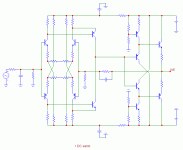Hi all,
Couple of years ago I published simple discrete preamp, Dispre. The preamp was well accepted and became quite popular. There was a thread on DIY audio:
http://www.diyaudio.com/forums/showthread.php?threadid=64843&highlight=
and an article in Klang und Ton by Holger Barske:
http://www.symasym.holgerbarske.com/doku.php?id=dispre
http://www.symasym.holgerbarske.com/doku.php?id=gemeinsames
also, my original page: http://web.telecom.cz/macura/dispre_en.html
I have decided to come with new, complementary-symmetrical version of Dispre. The new topology results in vanishingly low distortion (less than 0.001%) and uses very small amount of feedback (10dB), just to help to stabilize DC output. Open loop gain is 1MHz! A servo is included, so no output cap any more. Here is the concept:
Couple of years ago I published simple discrete preamp, Dispre. The preamp was well accepted and became quite popular. There was a thread on DIY audio:
http://www.diyaudio.com/forums/showthread.php?threadid=64843&highlight=
and an article in Klang und Ton by Holger Barske:
http://www.symasym.holgerbarske.com/doku.php?id=dispre
http://www.symasym.holgerbarske.com/doku.php?id=gemeinsames
also, my original page: http://web.telecom.cz/macura/dispre_en.html
I have decided to come with new, complementary-symmetrical version of Dispre. The new topology results in vanishingly low distortion (less than 0.001%) and uses very small amount of feedback (10dB), just to help to stabilize DC output. Open loop gain is 1MHz! A servo is included, so no output cap any more. Here is the concept:
Attachments
Nice 
I think your original Dispre was very very good, so it will be interesting to listen to your new one 😉

I think your original Dispre was very very good, so it will be interesting to listen to your new one 😉
aparatusonitus said:Hi PMA,
Is it a wise idea to put a EF buffer between complementary differential and FC BJT's?
I am not sure if I get it well. In case you mean to add EF follower between cascode's output and diamond buffer input, then I think it is not needed. The output diamond buffer has so high input impedance and so low input currents, that it does not need additional emitter follower.
In case you mean to put it in front of cascodes, then I am not sure.
PMA said:In case you mean to put it in front of cascodes, then I am not sure.
Yes, I mean in front of cascodes, THD numbers should go down in theory (sim) as we are isolating VAS transistors from current fluctuation in comp. differentials, as I understand it.
Have you tried OLG and OLG rolloff frequency - I want to keep very high OLG rolloff corner (now 1MHz), i.e. flat OLG frequency response; and low feedback (now 10dB).
No, I have not tried anything with that circuit, it's just quick and dirty copy-paste parts of my various circuit, so values of resistors and others elements are not correct, it's just for the show...It's time to have my lunch, so latter I maybe put some oscilograms if I have time...have to work you know.

To me, distortion is low enough now, so I do not intend to add another active devices
Wise decision, Pavel 😉
pavel:
nice design
your biasing of the input differentials is interesting.
are you willing to share any rational?
mlloyd1
nice design
your biasing of the input differentials is interesting.
are you willing to share any rational?
mlloyd1
Well, it is quite usual way how to bias and control gain of diff pair with resistors, and also local FB is added. This way I keep low OLG and wide OLG bandwidth.
Hello Ladislav,
yes, I did. According to simulation result, noise of the new version referred to input, is 3x lower compared to old version.
Regards,
Pavel
yes, I did. According to simulation result, noise of the new version referred to input, is 3x lower compared to old version.
Regards,
Pavel
Hi PMA,
Would you try to connect output buffer transistor collectors to output and simulate THD vs regular connection?
Would you try to connect output buffer transistor collectors to output and simulate THD vs regular connection?
- Home
- Source & Line
- Analog Line Level
- New DISPRE preamp, successor to previous popular version



